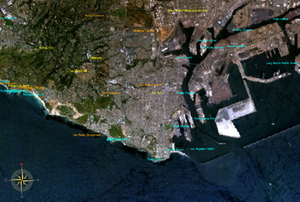Recent Risk and Policy Institute’s projects have included various reports and meetings concerning Rancho LPG and its location.
Related events include:
Testimony given at the City of Los Angeles Planning Commission meeting regarding the Ponte Vista development project on November 17, 2013. See http://issuu.com/randomlengthsnews/docs/rln_11-28-13_edition .
President Obama issues Executive Order — Improving Chemical Facility Safety and Security on August 1, 2013. See http://www.whitehouse.gov/the-press-office/2013/08/01/executive-order-improving-chemical-facility-safety-and-security .
California state Sen. Ted W. Lieu asks state fire officials to review safety of San Pedro, RPV propane, butane tanks on August 1, 2013. See http://sd28.senate.ca.gov/news/2013-08-01-sen-ted-w-lieu-asks-state-fire-officials-review-safety-san-pedro-rpv-propane-butane- .
Rep. Waxman calls on DHS to Review Risks at Rancho Facility and in CFATS Program on July 31, 2013. See http://waxman.house.gov/press-release/rep-waxman-calls-dhs-review-risks-rancho-facility-and-cfats-program .
For a PDF of the presentation at the San Pedro Leadership Forum of February 23, 2013, clickhere. Also see http://www.nbclosangeles.com/on-air/as-seen-on/192779711.html for news coverage of the event.
Because of its adjacency to residential neighborhoods, the Rancho LPG Holdings, LLC butane storage facility in San Pedro, California has been controversial since it was built in the early 1970s. From its conception, local residents have opposed its siting and have continued to voice concern about its operation. This study’s insights can be summarized as follows:
- There is a significant difference in the risk management of planned versus existing hazardous facilities. In Unbuilding Cities: Obduracy in Urban Sociotechnical Change, Hommels comments extensively about the persistence of ill-conceived and unwanted infrastructure in urban environments. Rancho LPG is an example of obduracy due to embeddedness. The persistency of Rancho LPG is due, in part, to its relative rigidity and irreversibility with respect to zoning, legal developments, and the “’deep-rooted [American] ideological antipathy to government intervention in urban and regional developments’” (Hommels, p. 13).
- From a policy perspective, it is a bad idea to exempt facilities from regulations without a sunset clause. It is improbable that, if built from scratch, Rancho LPG would be licensed today at its current location given current regulations and other requirements such as an EIS and a QRA. From a macro-level perspective, the example of Rancho LPG highlights the absurdity of unlimited grandfathering in zoning. The original rationale for grandfathering was that significant, sudden regulatory change hurts existing facilities and discourages future investment. Arguments centering on “fairness” and “economic feasibility” (e.g., it is less expensive to implement pollution controls at the time of new construction rather than as a retrofit) were developed to favor the owners of infrastructure. In retrospect, however, the obvious problems of grandfathering emerged. By creating a permanent, regulatory environment favoring existing facilities, grandfathering established a perverse incentive to keep aging facilities open. The grandfathered status of Rancho LPG may have become its most valuable asset. Protecting that asset has meant defending the facility, even at the potential expense of downplaying public safety and, in the case of its expired marine shipping permit, operating less efficiently. When an area’s zoning changes, whether it be economically positive zoning with respect to the property owner (i.e., for “war emergency” purposes) or economically negative zoning with respect to the property owner (i.e., new pollution regulations or the requirement of an EIR), the implementation of grandfathering, at least with respect to public safety and environmental compliance issues, should either be eliminated or strictly delimited in scope and time.
- Siting of aboveground LPG storage facilities near other critical infrastructure or near population centers should always be avoided and, when present, rectified. Alternative siting, hardening, and additional security can be established as very effective tools in reducing both reducing conditional and unconditional expected losses. Siting of aboveground LPG storage facilities in areas with low densities at least four miles from population centers and at least two miles from other significant commercial enterprises to minimize the exposure of people and property to potential harm should be strongly preferred in the regulatory approval process, and full containment of facility tanks should be mandatory.
- The persistency of Rancho LPG may also be due to its significant sunk costs. Political decisions often consider sunk costs, and avoidance of this consideration can only be accomplished absolutely by use of prospective analysis of proposed sites rather than retroactive analysis of existing sites.
